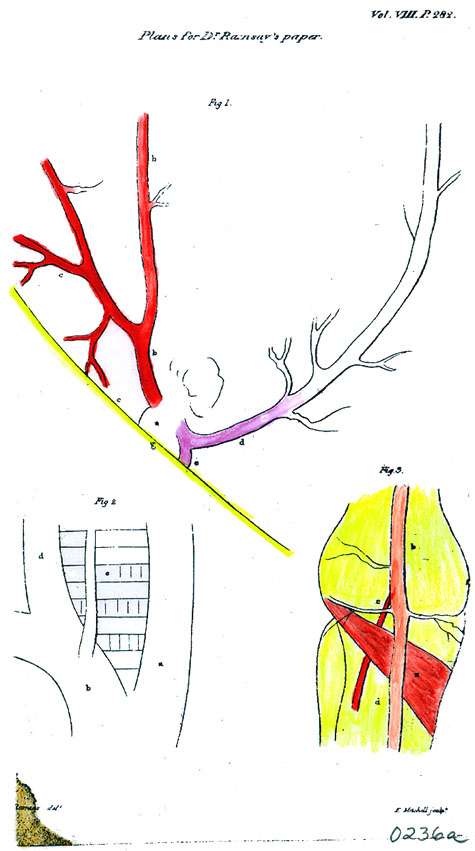

Illustrated Encyclopedia of Human Anatomic Variation: Opus II: Cardiovascular System
Ronald A. Bergman, PhD
Adel K. Afifi, MD, MS
Ryosuke Miyauchi, MD
Peer Review Status: Internally Peer Reviewed

from Ramsay, 1813.
Fig. 1. "The distribution of vessel, b. seems not frequent, and accounts for fatal haemorrhage in the operation fro paracentesis. It is surprising that practitioners seem never to have examined such cases after death, and surgeons have rather adopted the new method of operation, from experience of the occasional danger connected with this operation, than a conviction and knowledge of the vessel injured in such cases. In fig. 1, (a) is the external iliac artery. Here the the circumflex (c, c) is not sent off as a principal trunk, but as a branch of b, a large ascending artery, exceeding the diameter of a crow quill,
which passes in the course of the trocar. In this subject, this distribution was found on the right side only; but it occurs occasionally on both sides. The symptoms of gradual sinking after the operation, which has been known to continue for three days, and terminate in death, ought to warn practitioners of the possibility of the presence and section of this artery, which is easily taken up, as it lies (so far as my observation goes) between the external and internal oblique muscles of the abdomen. This vessel seems to occur once in 200 cases, were I to conclude from those I have met with; though this artery, upon a small scale, may be detected often, and seems the cause of the bloody tinge which occasionally appears in even successful operation. d, is the epigastric artery which is sent off, e, the obturator artery, a circumstance much more frequent than I find is credited; and so far as this has influence in operations, practitioners ought to be aware of this frequency. f, Is the superior anterior process of the os ilium; g, Pouparts ligament."
"Fig. 3d, exhibits the anterior tibia artery, c, sent off higher than usual from the popliteal artery, and is subjected to the continual pressure of the popliteal muscle, a, between which, and the tibia, d. this unusual distribution passes to its destination. Is aneurismal affection excited by such circumstances?" This article by Ramsay also contains the original description of the axillary arch (achselbogen) muscle. He observed it in 1795 but was published here in 1813. The discovery of this muscle is commonly attributed to Langer (reported in 1846). See Part 1 of this series for details and other references. from Ramsay, 1813.
Section Top | Title Page
Please send us comments by filling out our Comment Form.
All contents copyright © 1995-2024 the Author(s) and Michael P. D'Alessandro, M.D. All rights reserved.
"Anatomy Atlases", the Anatomy Atlases logo, and "A digital library of anatomy information" are all Trademarks of Michael P. D'Alessandro, M.D.
Anatomy Atlases is funded in whole by Michael P. D'Alessandro, M.D. Advertising is not accepted.
Your personal information remains confidential and is not sold, leased, or given to any third party be they reliable or not.
The information contained in Anatomy Atlases is not a substitute for the medical care and advice of your physician. There may be variations in treatment that your physician may recommend based on individual facts and circumstances.
URL: http://www.anatomyatlases.org/